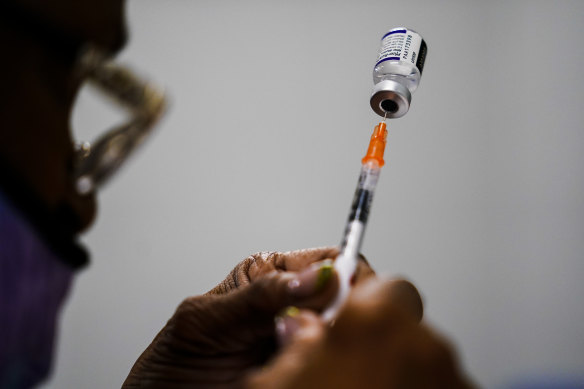‘Moving target’: US health officials start work on annual COVID vaccine plan

Washington: US health officials would like to get the frequency of COVID-19 shots down to just one a year, and on Thursday they began discussing how to do that.
The message has come through loud and clear that Americans have already had enough of frequent COVID shots. Food and Drug Administration advisers are meeting to discuss issues such as which strains of coronavirus would be in an annual vaccine, and how they would be chosen.
A syringe is prepared with the Pfizer COVID-19 vaccine at a vaccination clinic in Chester, Pennsylvania.Credit:AP
Documents released earlier this week compared the America agency’s desired approach to the annual flu immunisation effort. As it stands now, anyone getting a COVID shot for the first time receives a vaccine designed in 2020, when the virus looked a lot different than it does today. The new strategy would require health officials to meet each year to review which strains of the virus should be included in the shots, just as they do with flu, for use each September ahead of the northern winter.
“I don’t think that we can chase after every new variant that comes along because the virus is changing so much,” said committee member Stanley Perlman, professor of immunology at the University of Iowa who sits on the FDA panel. “It makes it harder to convince people because if someone doesn’t want to get a shot every four months, the response might be ‘Well, I’m not going to get a shot at all’.”
Healthy adults would receive one COVID shot each autumn in the FDA plan, while children, the elderly and those with compromised immunity would receive two doses. Ad-hoc boosters could be used if a particularly vaccine-evasive strain of COVID arose.
Drugmakers Moderna, Pfizer and Novavax are scheduled to present clinical data on their shots. FDA staff and advisers discussed safety signals seen in one database that detected a higher risk of stroke among older adults who had received Pfizer’s updated booster. The signals were not picked up in other large databases, FDA officials said, but the agency would continue investigating the issue.
The FDA also said it planned to conduct an epidemiological study assessing the co-administration of flu and COVID vaccines before the 2023-2024 influenza season. Moderna and Pfizer are each developing shots that would target both viruses.
When the FDA’s advisory committee on vaccines last convened in June, they proposed the booster currently in use that targets Omicron variants that were prevalent at that time. The move raised the possibility of creating new boosters to combat each new variant.
Experts are divided on whether this would be the best way to continue addressing COVID-19. Not long after the booster shots were rolled out in September, new variants were on the rise. The new shots didn’t turn out to be that popular. Just 15 per cent of Americans have gotten the latest booster, according to data from the Centres for Disease Control and Prevention.
At the next meeting, the experts will review CDC data on COVID trends and variants and the effectiveness and safety of the initial vaccine and the latest booster. They will also hear from the National Institutes of Health on the development of next-generation vaccines.
The advisory committee will review this data, discuss the issues and make recommendations to the agency. The FDA isn’t obligated to follow their recommendations, but it typically does.
“There are a lot of rumours and gossip and anecdotal cases that people want to share, but really we want to see the data,” said Archana Chatterjee, dean of the Chicago Medical School and member of the panel. “What is being reported in terms of adverse events? What is the effectiveness of the vaccine in the face of these variants? This is a moving target.”
Bloomberg
Most Viewed in World
From our partners
Source: Read Full Article
